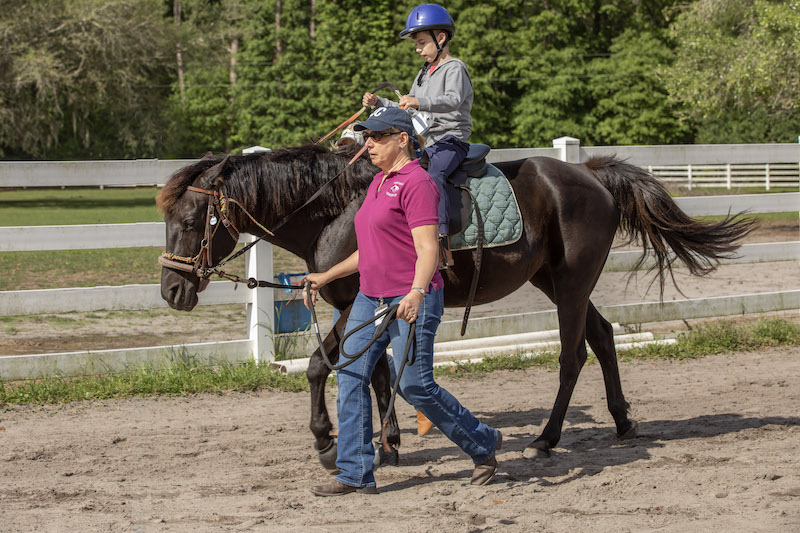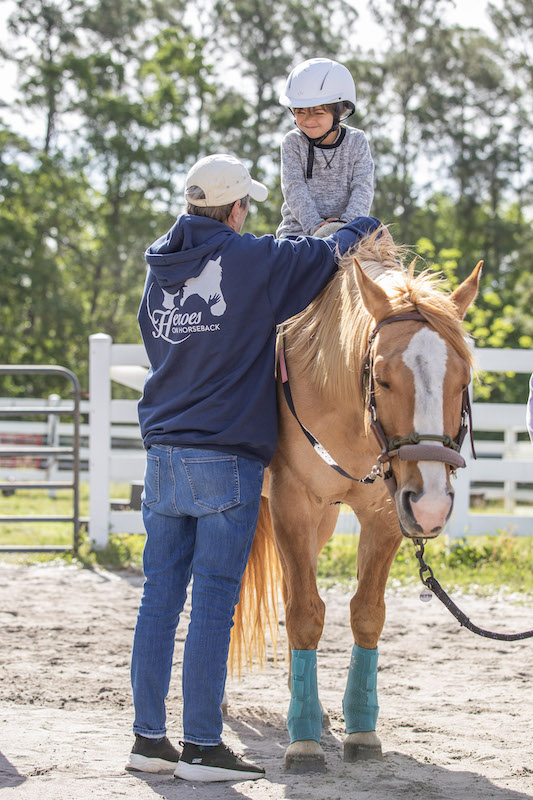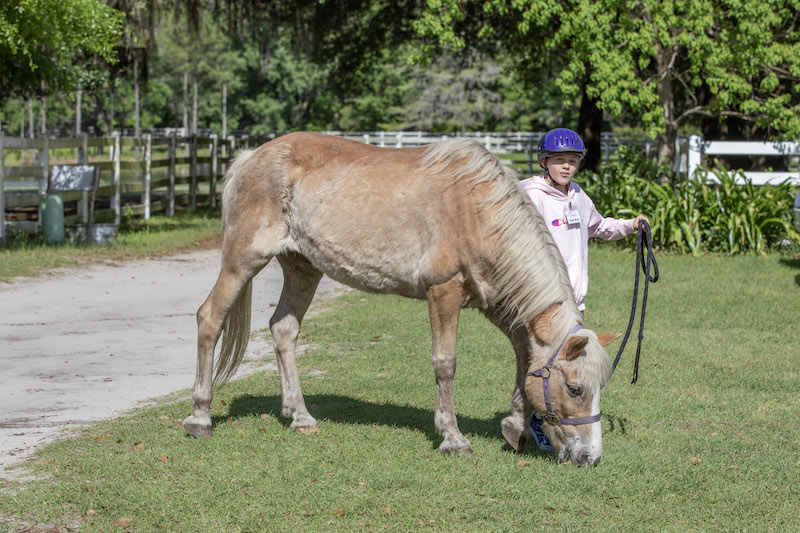For thousands of years, the bond between man and animal has proven to be effective in creating an emotional, healing effect. Horses are used by physical, speech, and occupational therapists to reach their patients on a personal level through what is referred to as “hippotherapy.” At Heroes on Horseback, located at 95 Stillwell Rd. in Bluffton, individuals with special needs participate in a variety of equine-assisted activities and therapy that enrich their lives by providing hope, healing, and opportunities for success.
Heroes on Horseback (HOH) was founded 23 years ago by two equestrian women who learned about the therapeutic impacts between horses and special needs individuals. HOH works with the special education classes of Beaufort and Jasper County Schools—both public and private/home schooled. As well, the organization works with disabled military, both retired and active duty, along with emergency responders, many of whom suffer with some form of post-traumatic stress disorder (PTSD).

Declan riding Jenna with Laura Badger as Horseleader
“Horses have a unique, survival instinct that allows them to detect emotions within humans that no other human or animal can detect,” explained Robert (Bob) Lee, executive director at Heroes on Horseback. “It is this sensitivity to our moods that makes equines the perfect therapists for special needs children and adults as well as veterans and others struggling with many forms of emotional, mental, and physical challenges.”
HOH is a member of PATH International (Professional Association of Therapeutic Horsemanship), a worldwide organization with approximately 900 member centers all over the world. PATH provides the programming, the volunteer training, and the instructor training for equine therapy centers. Different levels of accreditation are achievable—the topmost being the premier accreditation, which is the level held by HOH.
“Every five years, they come out to our facility,” Lee said. “They examine all of our programs, our facility, our safety procedures, and they observe our classes to make sure that we’re complying with their program materials.”
Because HOH works collaboratively with the schools, the district provides transportation for students to and from the 20-acre facility. When the students arrive, one third of them will go to the riding arena and ride the horses, typically with a horse leader and two side walkers.

Gideon riding Drifter with Colleen Townsend as Sidewalker
“A certified instructor gives the rider tasks to perform while they’re controlling a 1000-pound animal,” Lee said. “So, it’s not just a matter of trying to center yourself and keep yourself from falling off the horse. The rider must follow the instructions—whether it’s maneuvering the horse from point A to point B, or starting and stopping, or backing up, or stopping and throwing a ball through a hoop—they must carry out the physical tasks while controlling the animal.”
One third will practice horsemanship on the ground, standing next to the horse. They learn everything about the horse, including anatomy and the equipment of horsemanship. Importantly, the more they know about horses, the better they do when they begin riding the horses.
“In this class, they learn how to interact with a horse and speak its language,” Lee said. “They learn ear positioning: ears pinned back mean the horse isn’t happy; ears perked up, the horse is listening and will follow instruction, etc. They learn voice commands and the parts of the horse, so that when they are riding, they know why the horse is reacting in certain ways. They learn what the horse will do when they press their knees into the horse or how they position the reins.”
The other third of the students will take a horse-inspired art class. Most of the participants are somewhere on the spectrum, and art is a major component for empowering an autistic child.

“They draw horses and play with models, following the verbal instructions of the art instructor,” Lee said. “This, again, helps the students learn anatomy and feel comfortable that they know the animals, as well as the communication skills they are receiving through verbalization, listening, comprehending, and executing.”
Each class lasts one hour, then the students rotate to the other two classes, bringing their total time at HOH to three hours per day. Sessions last for six weeks. A student in a special ed class gets a total of 18 hours of equine therapy at HOH.
At HOH, instructors and volunteers are also certified Special Olympic Coaches, so participants can train for Special Olympics equine events. While they’re getting PATH training, they’re also participating in equestrian competitions for Special Olympics.
“It’s such a cool thing,” Lee said. “In addition to the coaching and the training that they get at HOH, these athletes get to participate in the Special Olympics World Games (which are held every four years), the USA Games, and the South Carolina State Games (both of which are annual events).”

Laura Kinsey, lead instructor
To gain an appreciation of the impact HOH is having at Special Olympics, consider these statistics: At the 2015 World Games in Los Angeles, one of the 10 Americans came from HOH in Bluffton; at the 2011 World Games in Athens, Greece, two of the 10 Americans came from HOH Bluffton, one of which was the USA Equestrian Team Captain. These three athletes—who competed at two World Games, entered a total of nine equestrian events, and medaled in five of those events—earned two gold medals, one silver, and two bronzes.
“This is a tremendous opportunity because as these individuals compete and achieve success in equestrian, it gives them a lot of self-confidence, which spills over to all aspects of their lives—at home, at school, at work,” Lee said. “These folks are like anybody else. They want to experience success and be recognized for it.”
While the staff and volunteers are sure that the programs at HOH work well, they also realize that the ultimate test is how their participants succeed cognitively and physically and then duplicate those improvements in other areas of their lives. And they hear repeatedly from schoolteachers, therapists, caregivers, and parents that the transformation is impactful.
One success story involves a special needs Hilton Head Island High School student who rode at HOH for about 10 years. While he participated in a variety of sports, he showed a proclivity for the horses and was selected to represent the United States in the Special Olympic World Games in Greece, competing as an equestrian.

A family of geese make their way to the water.
“This kid had probably never been out of the Southeastern United States, much less travelling to Athens, Greece,” Lee said. “When he came back, he had completely broken out of his shell. I would take him with me to different events to speak about HOH because, as a member of the program, he did a much better job of pitching and selling it.”
From there, the student got a job. Today, he works at Walmart and the Hampton Inn and was recently voted Hampton Employee of the Year.
“He got his driver’s license, even bought his first vehicle,” Lee said. “I’m not saying that we were the sole reason he was able to achieve that, but at HOH, he experienced success that developed the character and confidence a person needs to be able to go out and succeed at other things.”
Another success story Lee shared involved a military veteran—still in the program today—who had a non-combat injury that resulted in a concussion, brain damage, and confinement to a wheelchair. His symptoms were much like someone who had suffered a serious stroke, including an inability to communicate and use one side of his body. At the VA, his wife and daughters were told not to expect much in the way of recovery.
“When he came to us, it took two large men to lift him onto the horse. Today, he walks with a cane, he’s earned his college degree, he can communicate well,” Lee said. “So, we know this therapy works. When we bring somebody into the program, we meet with the caregivers, the parents, the teachers, the therapists to get an idea of the diagnosis, what the goals are, and how we can measure ourselves against that goal. Because it’s more than just having fun on horseback. We are really trying to treat whatever that challenge is in a non-clinical setting.”
So how does one afford to participate in equestrian therapy? Because HOH works in collaboration with both the school districts and the Special Olympics, the costs are shared. The school’s contribution is the bus rides they provide to and from the program. Special Olympics and HOH split the $700 cost per participant/per session. Of HOH’s portion, 90 percent is covered by contributions, donations, and grants. No one is ever turned away from the program if they can’t afford to pay, and tuition assistance and scholarships are available.
To learn more or to become a volunteer or instructor, visit heroesonhorseback.org.



